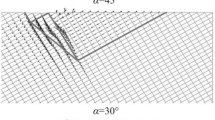Abstract
The magnitude of earth pressure of jointed rock wedges against a support system was investigated both analytically and numerically. Analytical method was based on the wedge analysis and numerical method was based on the discrete element method. To consider various rock wedge conditions, the controlled parameters included the rock type, number of joint, and joint shear condition. The results of analytical method were compared with the numerical test results. The comparison showed that the earth pressure of jointed rock wedges can be assessed larger by the analytical method than the numerical method and as the number of joints increases, the results of both methods becomes closer. In addition, the results indicated that the earth pressure of jointed rock wedges was strongly dependent on the rock type, number of joint, and joint shear condition. This study suggested that both the ground-structure interaction and rock and joint conditions are important for assessing the earth pressure of jointed rock wedges, and these factors should be considered when designing a support system economically and reasonably against jointed rock wedges.
Similar content being viewed by others
References
Chae, Y. S. and Moon, I. (1994). “Earth pressure on retaining wall by considering local soil condition.” Korean Geotechnical Society’ 94 Fall Conference Paper, pp. 129–138.
Coulomb, C. A. (1776). Essai sur une application des regles des maximis et minimis a quelques problemes de statique relatifs a l’architecture, Mem. Math. Phys. Acad. Roy. Sci. par divers Savans, Vol. 7. Paris.
Haahash, Y. M. A. and Whittle, A. J. (2002). “Mechanism of load transfer and arching for braced excavations in clay.” Journal of Geoteh and Geoenviron. Eng., Vol. 128, No. 3. pp. 187–197.
Itasca Consulting Group, Inc (2004). Universal distinct element code, User’s Manual, Minneapolis, Minnesota, U.S.A
Jeong, E. T. and Kim, S. G. (1997). “Case study of earth pressure distribution on excavation wall of multi-layered soil.” Korean Geotechnical Society’ 97 Spring Conference Paper, pp. 78–80.
Laio, S. S. C. and Neff, T. L. (1990). “Estimating lateral earth pressure for design of excavation support.” Proceedings, Design and Performance of Earth Retaining Structures, ASCE Special Conference, Ithaca, New York, pp. 489–509.
Lambe, T. W. and Whitman, R. V. (1978). Soil mechanics, SI version, John Wiley & Sons Inc., New York.
Peck, R.B. (1969). “Deep excavations and tunneling in soft ground, state-of-the-art report.” Proceedings of the 7th International Conference on Soil Mechanics and Foundation Engineering, Mexico City, State-of-the Art Volume, pp. 225–290.
Potts, D. M. and Fourie, A. B. (1986). “A numerical study of the effect of wall deformation on earth pressures.” Intern. Journal of Numerical Ana. Methods in Geomech., Vol. 10, No. 4, pp. 383–405.
Prakash, S. and Saran, S. (1966). “Static and dynamic earth pressures behind retaining walls.” Proc., 3rd Symposium on Earthquake Engineering, University of Roorkee, Roorkee, Vol. 1, pp. 277–288.
Son, M. (2013). “Earth pressure on the support system in jointed rock mass.” Canadian Geotechnical Journal, Vol. 50, No. 5, pp. 493–502.
Son, M. and Park, J. (2014). “Physical model test and numerical simulation of excavation walls in jointed rock masses.” Canadian Geotechnical Journal, Vol. 51, No. 5, pp. 554–569.
Son, M. and Yoon, C. (2011). “Characteristics of the earth pressure magnitude and distribution in a Jointed Rockmass.” Journal of the Korean Society of Civil Engineer., Vol. 31, No. 6, pp. 203–212.
Tschebotarioff, G. P. (1973). Foundations, Retaining and Earth Structures. 2nd Ed., MGH.
Wong, I. H., Poh, T. Y., and Chuah, H. L. (1997). “Performance of excavations for depressed expressway in Singapore.” Journal of Geoteh. and Geoenviron. Eng., Vol. 123, No. 7, pp. 617–625.
Worden, F. T. and Achmus, M. (2013). “Numerical modeling of three-dimensional active earth pressure acting on rigid walls.” Computer and Geotechnics, Vol. 51, pp. 83–90.
Yoo, C. S. and Kim, Y. J. (2000). “Deep excavation in soil, including rock with layers on retaining wall and apparent horizontal displacement of earth pressure.” Journal of Korean Geotechnical Society, Vol. 16, No. 4, pp. 4350.
Author information
Authors and Affiliations
Corresponding author
Rights and permissions
About this article
Cite this article
Son, M., Adedokun, S. Comparison of earth pressure between numerical and analytical methods for jointed rock wedges. KSCE J Civ Eng 19, 2075–2082 (2015). https://doi.org/10.1007/s12205-015-0318-z
Received:
Revised:
Accepted:
Published:
Issue Date:
DOI: https://doi.org/10.1007/s12205-015-0318-z




